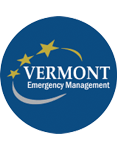Guidance for private homeowners:
1. Is the public road to the residence accessible for emergency access? If no, they should contact their Town’s Emergency Management Director. If they don’t know who that is, they can contact the Town Clerk’s office, and/or the Road Commissioner to report the public road damage.
2. Is the driveway accessible for emergency access? See “B”, below.
3. Do any inhabitants have acute medical or special functional needs? If yes, this should also be communicated to the local Emergency Management Director. People with urgent medical emergencies should of course call 911. People with ongoing medical transport needs should call 211.
4. A streambank has eroded, and structures on my property are in imminent peril of being damaged or washed away in the next storm (E.g. “…My garage is hanging over the embankment…”, “…My entire driveway is going to slip down the hill…”). The Natural Resources Conservation Service’s Emergency Watershed Protection Program (EWP) may be able to assist. Eligibility for EWP is described here (link to VT EWP Key Program Points). Note that EWP only covers exigent risk, so if structural damage has already occurred it is too late for this program (skip to question B). Requests for a site visit from NRCS EWP (link to brochure) must be submitted via a Request Letter from the Town (link to VT Sample Request for EWP Assistance Letter). Contact for more information about EWP: Michel Lapointe, P.E., Civil Engineer, USDA-NRCS, 300 Interstate Corporate Center, Suite 200, Williston, VT 05495-7821, (802) 288-8155 x 118, (802) 324-0377 Cell.
Question: My driveway was washed out. What should I do and who can help?
Answer: Generally private residents are responsible for maintaining and repairing their own driveways.
--If you have an emergency and need immediate assistance, call 911.
--Call your homeowners insurance company to report the damage and file a claim if the damage is eligible under your insurance policy.
--Call your town and report your damages to the local Emergency Management Director.
--Call local contractors to get quotes on repairs.
C. Question: Is there federal Public Assistance funding available from FEMA for town repairs of private driveways?
Short Answer: No.
Long Answer: If a federal disaster is declared, the town may qualify for 75% federal reimbursement of eligible “emergency protective measures” under the Public Assistance program. That includes costs of restoring emergency access on town roads (if total town costs exceed $3,200), but it does not include repairs of private drives. If a town received an emergency call due to the disaster, their response costs are eligible if supported by a call log. However, if a town pre-emptively repairs private drives to reestablish emergency access that is not FEMA-eligible.
FEMA does allow some latitude in cases where towns take a generous approach to access restoration (for example, many towns will repair or re-place small culverts which blow out at the toe of private driveways where they cross ditches along town roads, not quibbling about whether those lowest culverts are entirely within town right-of-way). But repairing a whole private driveway is not within the Public Assistance. Private driveway problems should be solved at the individual and/or community level.
D. Question: Our town is repairing damages, and we heard something about FEMA’s “70-hour rule”. When do we need to stop contractors and do formal procurement?
Answer: FEMA used to have a rule allowing towns to contract for up to 70 billable hours of “temporary work” with few contract restrictions. That rule is no longer in effect. There is nothing hard and fast about a specific number of billable hours. Rather, FEMA differentiates between temporary/emergency repairs (e.g. to restore traffic flow and emergency access) vs. permanent repairs. For the first several days after a flooding event, FEMA understands that towns “do what they need to do”, including hiring available contractors on an emergency basis to restore basic services. However, when the temporary work is done and the town starts to do permanent repairs, that work needs to be properly designed, permitted, and procured. In general, we recommend that towns complete basic repairs as soon as possible, but that they should not have contractors doing large permanent repairs without having gone through competitive procurement.
Good threshold questions for towns to ask before proceeding with additional contracted work:
--Does the work need a permit? If yes, get the Agency of Natural Resources River Engineer’s input before proceeding with design.
--Does the work need professional engineering? If yes, put the engineering plans out to competitive bid.
--Does the contracting for permanent repairs follow your local procurement policy? It always should.
--Will the procurement comply with federal law regarding small and minority-and-woman-owned businesses? You may be asked by FEMA to demonstrate that you made an affirmative effort to make your procurement opportunity available to all. A good way to do that is to post your RFPs via Vermont’s Procurement Technical Assistance Center (it is free to register and post projects): https://accd.vermont.gov/economic-development/programs/ptac.
--Will the work cost more than $150,000? If yes, federal procurement law kicks in and requires solicitation of formal written bids.

